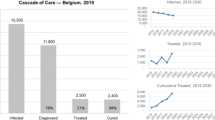Abstract
Background
The relationship between the hepatitis B e antigen (HBeAg) seroconversion and the long-term natural history of liver disease has not been sufficiently investigated.
Methods
A total of 408 [4352 person-year (PY) units] patients with chronic hepatitis B virus (HBV) without antiviral therapy were enrolled. The study patients were divided into three groups, as follows: Group A (2666 PY units), seroconverted of HBeAg at age < 40; Group B (413 PY units), seroconverted of HBeAg at age ≥ 40; Group C (1273 PY units), persistently HBeAg positive. Yearly transition probabilities from each liver state [chronic HBV infection, chronic hepatitis B, cirrhosis, hepatocellular carcinoma (HCC), and hepatitis B surface antigen (HBsAg) negativity] were calculated using the Markov chain model.
Results
In the analysis of 1 year liver disease state transition probabilities, the liver states remained almost the same in Group A. In Groups B and C, each liver state tended to progress to a worse state. Assuming a chronic hepatitis B state at age 40 as the starting condition for simulation over the next 40 years, the chronic hepatitis B state accounted for approximately 60% of males aged ≥ 50 and approximately 40% of females aged ≥ 60 in Group A, and the HBsAg-negative state accounted for approximately 30–40% of males and females aged ≥ 60. In Groups B and C, the probabilities of patients with cirrhosis and HCC gradually increased with age.
Conclusions
Not only patients with persistent HBeAg positive, but also patients with delayed HBeAg seroconversion showed poor prognosis of liver-related natural history.





Similar content being viewed by others
Abbreviations
- HCC:
-
hepatocellular carcinoma
- HBsAg:
-
hepatitis B surface antigen
- HBV:
-
hepatitis B virus
- HBeAg:
-
hepatitis B e antigen
- AST:
-
aspartate aminotransferase
- ALT:
-
alanine aminotransferase
References
Stanaway JD, Flaxman AD, Naghavi M, et al. The global burden of viral hepatitis from 1990 to 2013: findings from the Global Burden of Disease Study 2013. Lancet. 2016;388:1081–8.
Beasley RP, Hwang LY, Lin CC, et al. Hepatocellular carcinoma and hepatitis B virus. A prospective study of 22 707 men in Taiwan. Lancet. 1981;2:1129–33.
Szmuness W. Hepatocellular carcinoma and the hepatitis B virus: evidence for a causal association. Prog Med Virol. 1978;24:40–69.
Rustgi VK. Epidemiology of hepatocellular carcinoma. Gastroenterol Clin North Am. 1987;16:545–51.
European Association for the Study of the Liver. EASL. Clinical Practice Guidelines on the management of hepatitis B virus infection. J Hepatol. 2017;67:370–98.
Raffetti E, Fattovich G, Donato F. Incidence of hepatocellular carcinoma in untreated subjects with chronic hepatitis B: a systematic review and meta-analysis. Liver Int. 2016;36:1239–51.
Hadziyannis SJ. Hepatitis B e antigen negative chronic hepatitis B: from clinical recognition to pathogenesis and treatment. Viral Hepat Rev. 1995;1:7–36.
Hadziyannis SJ, Vassilopoulos D. Hepatitis B e antigen-negative chronic hepatitis B. Hepatology. 2001;34:617–24.
Fattovich G, Bortolotti F, Donato F. Natural history of chronic hepatitis B: special emphasis on disease progression and prognostic factors. J Hepatol. 2008;48:335–52.
Kew MC. Hepatitis viruses and hepatocellular carcinoma. South Afr Med J. 1994;84:550–6.
Chen YC, Chu CM, Liaw YF. Age-specific prognosis following spontaneous hepatitis B e antigen seroconversion in chronic hepatitis B. Hepatology. 2010;51:435–44.
Beck JR. Markov models of natural history. J Clin Epidemiol. 1988;41:619–21.
Sonnenberg FA, Beck JR. Markov models in medical decision making: a practical guide. Med Decis Mak. 1993;13:322–38.
O’Shea RS, Dasarathy S, McCullough AJ. Practice Guideline Committee of the American Association for the Study of Liver Diseases; Practice Parameters Committee of the American College of Gastroenterology. Alcoholic liver disease. Hepatology. 2010;51:307–28.
Li Y, Chen Y, Zhao Y. The diagnostic value of the FIB-4 index for staging hepatitis B-related fibrosis: a meta-analysis. PLoS One. 2014;9:e105728.
Terrault NA, Bzowej NH, Chang KM, et al. American Association for the Study of Liver Diseases. AASLD guidelines for treatment of chronic hepatitis B. Hepatology. 2016;63:261–83.
Liaw YF, Kao JH, Piratvisuth T, et al. Asian-Pacific consensus statement on the management of chronic hepatitis B: a 2012 update. Hepatol Int. 2012;6:531–61.
Kato H, Orito E, Sugauchi F, et al. Determination of hepatitis B virus genotype G by polymerase chain reaction with hemi-nested primers. J Virol Methods. 2001;98:153–9.
Liu CJ, Chen PJ, Lai MY, et al. Evolution of precore/core promoter mutations in hepatitis B carriers with hepatitis B e antigen seroreversion. J Med Virol. 2004;74:237–45.
Kao JH, Wu NH, Chen PJ, et al. Hepatitis B genotypes and the response to interferon therapy. J Hepatol. 2000;33:998–1002.
The Japan Society of Hepatology. Surveillance algorithm and diagnostic algorithm for hepatocellular carcinoma: clinical practice guidelines for hepatocellular carcinoma. Hepatol Res. 2010;40(Supplement s1):6–7.
Bruix J, Sherman M. Management of hepatocellular carcinoma. Hepatology. 2005;42:1208–36.
Bruix J, Sherman M. Management of hepatocellular carcinoma: an update. Hepatology. 2011;53:1020–2.
Chan HL, Wong VW, Wong GL, et al. A longitudinal study on the natural history of serum hepatitis B surface antigen changes in chronic hepatitis B. Hepatology. 2010;52:1232–41.
Jackson C. Multi-state modelling with R: the msm package. Cambridge, UK: MRC Biostatistics Unit; 2016.
Funding
This work was supported by Health and Labour Sciences Research Grants (Research on Hepatitis) from the Ministry of Health, Labour and Welfare of Japan.
Author information
Authors and Affiliations
Corresponding author
Ethics declarations
Conflict of interest
The authors declare no conflicts of interest.
Rights and permissions
About this article
Cite this article
Tada, T., Kumada, T., Toyoda, H. et al. Long-term natural history of liver disease in patients with chronic hepatitis B virus infection: an analysis using the Markov chain model. J Gastroenterol 53, 1196–1205 (2018). https://doi.org/10.1007/s00535-018-1467-x
Received:
Accepted:
Published:
Issue Date:
DOI: https://doi.org/10.1007/s00535-018-1467-x




